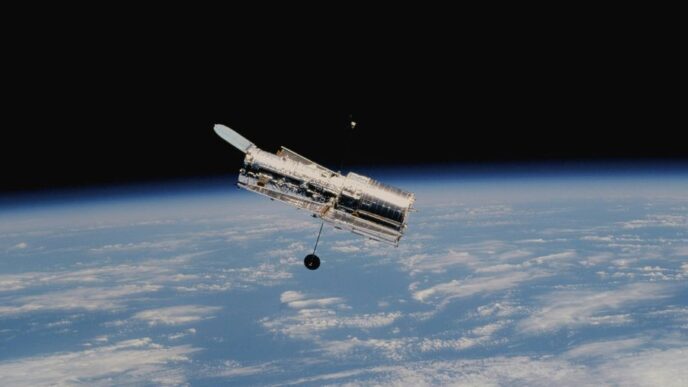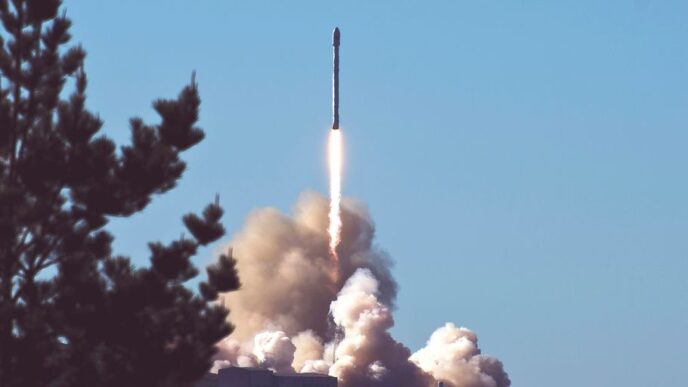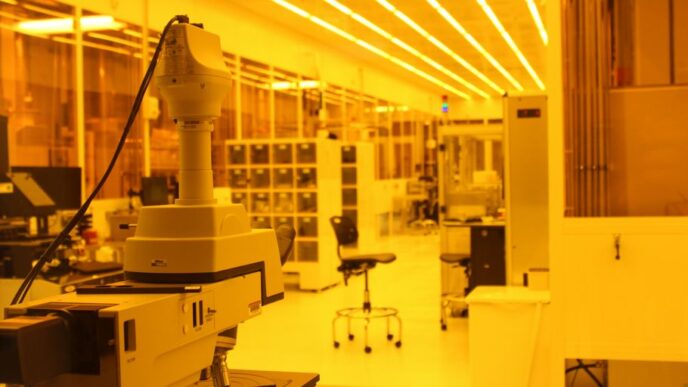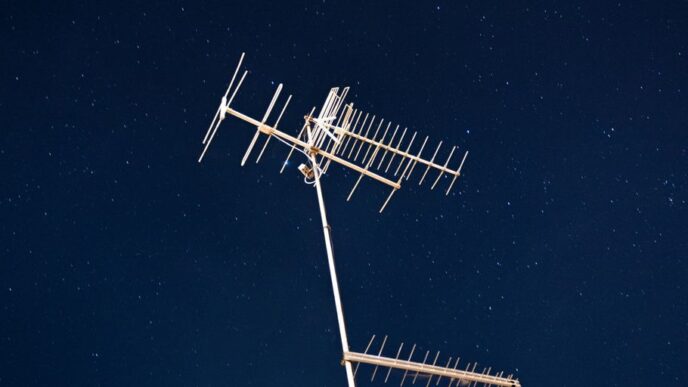SpaceX’s Starship program is always buzzing with activity, and the upcoming Flight 10 is no exception. While the exact launch date can shift due to the usual weather and technical checks, this test flight is a big deal for the company’s ambitious goals. We’ve got the latest starship news, including what to expect from this mission and how it fits into the bigger picture of space exploration.
Key Takeaways
- Starship Flight 10 faced delays due to weather, specifically an anvil cloud rule, and an earlier ground system issue.
- The mission profile includes a splashdown for the Super Heavy booster in the Gulf of Mexico, focusing on landing burn data.
- Key objectives for Flight 10 involve testing Starlink satellite simulator deployment and an in-space Raptor engine relight.
- Live coverage of the launch will be available through SpaceX’s official channels, Space.com, and NASASpaceflight.
- This test flight is vital for NASA’s Artemis program and SpaceX’s long-term Mars ambitions, building on lessons from previous flights.
Starship Flight 10 Launch Delays and Weather Concerns
Well, it looks like Starship Flight 10 is having a bit of a rough start with the weather. SpaceX had to call off the launch for the second day in a row. On Sunday, it was a ground system issue, which happens sometimes with these complex machines. But Monday’s scrub was due to something called an anvil cloud rule. Basically, if there’s a cloud with an anvil shape nearby, it’s a no-go for launches because of the electrical charge it can carry. It’s a bit frustrating when you’re waiting to see this massive rocket take off, but safety first, right?
SpaceX is pretty good at finding new opportunities, though. They’ve got backup days lined up, with Tuesday, August 26th, being the next target. The launch window is expected to open around 7:30 p.m. EDT. It’s a constant dance with the weather and the technical side of things.
Here’s a quick look at the timeline of delays:
- Sunday, August 24th: Initial launch attempt scrubbed due to a ground system issue (oxygen leak).
- Monday, August 25th: Second launch attempt scrubbed due to an anvil cloud formation near the launch site.
- Tuesday, August 26th: Next potential launch opportunity identified.
Understanding the Starship Flight 10 Mission Profile
Alright, let’s break down what SpaceX is trying to accomplish with Starship Flight 10. This isn’t just about getting off the ground; it’s a really detailed plan to test a bunch of different systems. Think of it as a complex checklist they’re working through.
First up, the Super Heavy booster. On this flight, they’re not going for the fancy ‘chopsticks’ catch. Instead, the plan is for the booster to do a controlled ocean splashdown in the Gulf of Mexico. This is a big deal because they want to gather data on its landing burn, which is the final engine firing to slow it down. They’re even going to intentionally shut down one of the center engines to see how the others compensate. This should happen about 6 minutes and 40 seconds after liftoff.
Then there’s the Starship upper stage itself. After separating from the booster, it’s got a few key jobs. Around 18 minutes in, it’s supposed to deploy eight Starlink satellite simulators. This is a repeat of a test from Flight 9 where the payload door didn’t open correctly, so they’re giving it another shot. Later, around 37 minutes, they’re planning to relight one of the Raptor engines in space – a test for future maneuvers. The really intense part comes later, about 47 minutes after launch, when Starship starts its reentry. This is where they’ll be testing out different heat shield materials and looking closely at how the vehicle’s flaps handle the extreme heat and pressure. They’re specifically testing the structural limits of those rear flaps during maximum entry conditions. The whole flight is expected to last a little over an hour, ending with Starship’s own landing burn and splashdown.
Here’s a quick look at some of the mission timeline highlights:
- Booster Ocean Splashdown: Targeting around T+6 minutes 40 seconds.
- Starlink Simulator Deployment: Planned for around T+18 minutes 27 seconds.
- In-Space Engine Relight: Scheduled for approximately T+37 minutes 48 seconds.
- Starship Reentry Begins: Expected around T+47 minutes 29 seconds.
It’s a packed schedule, and each of these steps provides valuable information for the next iteration of Starship. You can follow the whole thing live on the SpaceX official livestream.
Key Objectives for Starship Flight 10

Flight 10 is all about testing out some really important stuff for Starship. First up, they’re going to try deploying those Starlink satellite simulators again. Remember on Flight 9, the door didn’t open like it was supposed to, so this is a big chance to get that right. They’re hoping to get eight of these simulators out into space, which are basically dummy satellites.
After that, they’ve got a plan to relight one of the Raptor engines while Starship is already up there. This is a pretty big deal for future missions, especially if they need to adjust their course or do anything tricky in orbit. It’s scheduled to happen around 38 minutes into the flight.
And then there’s the heat shield. SpaceX is going to be trying out some different materials on the outside of Starship, including one that has active cooling. They’re also checking out how some metal fittings hold up, and they’ve smoothed out a section of the tiles on the side to see if that helps with the hot spots they saw on an earlier flight. They’re really pushing the limits with how Starship handles coming back through the atmosphere, especially with those big flaps on the back. The goal is to gather a ton of data on how these new parts and designs perform under extreme conditions.
How to Watch Starship Flight 10 Live
So, you want to catch Starship Flight 10 live? It’s a big deal, and thankfully, SpaceX makes it pretty easy to tune in.
SpaceX Official Livestream Details
SpaceX itself will be broadcasting the whole event. They usually kick off their stream about 30 minutes before the scheduled liftoff. You can find it on their X account (formerly Twitter), and it’ll also be available on their website’s mission page and the X TV app. It’s the most direct way to get the official feed.
Space.com and NASASpaceflight Broadcasts
If you like having options, or maybe want a bit more commentary, other sites will be carrying the launch too. Space.com will be simulcasting the SpaceX feed on their own homepage and YouTube channel. For those who want an even earlier start and more in-depth pre-launch discussion, NASASpaceflight usually starts their livestream much earlier, often a couple of hours before liftoff. They tend to provide a lot of background and analysis, which can be pretty interesting if you’re really into the details.
In-Person Viewing Locations
If you’re lucky enough to be near Boca Chica, Texas, you might consider watching in person. SpaceX doesn’t set up official public viewing areas, but there are spots that work. The Cameron County Amphitheater in Isla Blanca Park on South Padre Island is a popular choice; you get a decent view across the water. Just be aware that traffic can get pretty heavy as launch time approaches, so give yourself plenty of time to get there. There are also some spots along the shore near Port Isabel that offer views. Remember to check the latest launch window updates, as these can shift due to weather or technical issues.
Starship’s Role in Future Space Exploration

Starship isn’t just about getting to space; it’s about what we do once we’re there, and where we go next. SpaceX has some pretty big ideas for this rocket, and they’re not just small steps. Think about NASA’s Artemis program, for instance. They’re planning to use a version of Starship to land astronauts on the Moon. That’s a pretty huge deal, right? But it’s not just about the Moon. Elon Musk talks a lot about Mars, and Starship is the vehicle he envisions for getting people there and eventually building a city. It’s like a lifeboat for humanity, he’s said.
To make all these deep-space trips happen, a couple of things need to work really well. One is refueling in orbit. Nobody’s really done that on this scale before, and it’s a big engineering challenge. SpaceX needs to prove they can transfer massive amounts of super-cold fuel between ships while they’re up there.
Another big hurdle is the heat shield. Reentry into Earth’s atmosphere, or any planet’s atmosphere for that matter, gets incredibly hot. They’re testing different materials and designs to make sure Starship can handle that heat, flight after flight.
Here’s a look at some of the key areas Starship needs to master for these future missions:
- Orbital Refueling: Transferring propellant in space is a must for long-duration missions.
- Heat Shield Durability: Withstanding extreme reentry temperatures repeatedly.
- In-Space Assembly: Potentially building larger structures or spacecraft in orbit.
- Lunar and Martian Landing: Safely touching down on other celestial bodies.
Getting Starship to be fully reusable and capable of these kinds of missions is the goal. It’s a long road, and each test flight, even the ones that don’t go perfectly, provides data. That data is what helps them figure out what needs to be improved. It’s all part of the plan to eventually deploy large satellites, build space stations, and even send telescopes far out into the cosmos. You can follow the progress of these ambitious plans on the SpaceX official livestream.
Learning from Previous Starship Test Flights
SpaceX’s approach to developing Starship is all about learning from what happens, good or bad. They really lean into this idea of ‘fail fast, learn fast,’ which means they aren’t afraid to push the limits and see what breaks. It’s how they’ve gotten so far with their other rockets, like Falcon 9.
Looking back at the previous Starship test flights, there’s a lot to unpack. For instance, Flight 7 and Flight 8 both had issues that prevented them from completing their planned missions. Flight 9 also didn’t go as expected, with the payload door failing to open, meaning they couldn’t deploy the Starlink simulators. And let’s not forget the Starship that blew up during a ground test back in June. These aren’t just failures; they’re data points.
SpaceX uses this data to make changes. They’ve been adding upgrades to try and stop things like propellant leaks and engine shutdowns, which caused problems on some of the earlier flights. It’s a constant cycle of testing, analyzing, and improving. For example, they’re testing new heat shield tiles and looking at how the structure holds up during reentry. They really believe that repeated flights are key to figuring out what needs tweaking on the spacecraft. You can see this commitment to iterative improvement in their repeated flight testing.
Here’s a quick look at some of the issues and what they mean:
- Engine Shutdowns: Previous flights have seen engines shut down unexpectedly. This is a major focus for upgrades, aiming for more reliable engine performance.
- Structural Integrity: The extreme forces during launch and reentry put a lot of stress on the vehicle. SpaceX is closely watching how the Starship’s body and flaps handle these pressures.
- Payload Deployment: Getting the payload door to open and deploy satellites has been a challenge. Flight 10 aims to demonstrate this system working correctly.
- Reentry Performance: How Starship handles the intense heat and forces during its return to Earth is critical. They are testing different heat shield materials and designs to improve this.
It’s this willingness to try, to sometimes fail, and then to immediately apply those lessons that really defines SpaceX’s Starship program. They’re not waiting for perfection; they’re building it flight by flight.
Looking Ahead
So, Flight 10 didn’t quite go as planned, with weather and other issues causing delays. It’s a bit frustrating when you’re waiting to see this giant rocket fly, especially after previous tests had their own problems. But that’s kind of how it goes with this kind of cutting-edge stuff, right? SpaceX is trying to do something really big here, aiming for the Moon and Mars, and that means figuring out a lot of tricky details. They’re testing new heat shields, trying out different ways to land the big booster, and working on deploying satellites. Each flight, even the ones that don’t go perfectly, gives them more information. We’ll just have to keep an eye out for the next launch window and hope for better luck next time.
Frequently Asked Questions
Why was the Starship Flight 10 launch delayed?
SpaceX had to delay the launch of Starship Flight 10 twice. The first delay was because of a problem with the ground systems. The second delay happened because of bad weather, specifically an anvil cloud near the launch site, which isn’t safe for launching.
What is the main goal of Starship Flight 10?
The Starship Flight 10 mission is a test flight. SpaceX wants to see how the Super Heavy booster and the Starship upper stage perform. They are testing things like the booster’s landing burn in the ocean and the Starship’s ability to handle going through Earth’s atmosphere again.
What specific tests will happen during Starship Flight 10?
SpaceX hopes to test deploying eight fake Starlink satellites, which are like practice satellites. They also plan to test restarting one of the Starship’s engines while it’s in space. Plus, they’ll check how well the heat shield tiles and the rocket’s body hold up during the flight.
How can I watch the Starship Flight 10 launch?
You can watch the launch live on SpaceX’s official X (formerly Twitter) account. Other websites like Space.com and NASASpaceflight will also have live streams. Some people might also be able to watch from public viewing spots near the launch site in South Texas.
Why is Starship important for future space missions?
Starship is very important for NASA’s plan to send astronauts back to the Moon with the Artemis program. SpaceX also wants to use Starship to eventually send people to Mars and to develop ways to refuel rockets in space.
What has SpaceX learned from past Starship test flights?
SpaceX has learned a lot from previous test flights, even the ones that didn’t go as planned. They’ve made changes and added new parts to make the rocket more reliable. This approach of trying things out, learning from mistakes, and improving quickly is how SpaceX gets better.














